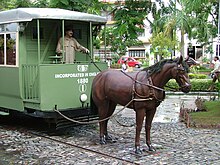Trams in India were established in the late 19th century. Horse-drawn trams were introduced in Kolkata in 1873; in Mumbai, trams began operations in 1874; in Nashik in 1889; electric trams began in Chennai in 1895, and trams were also introduced in Kanpur and Delhi. They were discontinued in all Indian cities between 1933 and 1964, except for Kolkata.
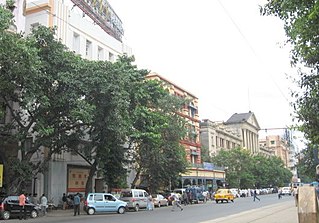
Esplanade is a neighbourhood of Central Kolkata, located at the heart of city with being the city's Central business district. This is a conventional esplanade because the Ganga river (Ganges), also known as Hooghly river, flows nearby and it is adjacent to the large fields of Maidan extending upto Fort William.
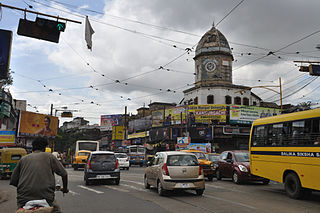
Maniktala is a residential area of North Kolkata, in Kolkata district, West Bengal, India.

Tollygunge is a locality of South Kolkata, in West Bengal, India. It is known for being the center of Indian Bengali-language cinema, with filming locations used for other regional Indian films.
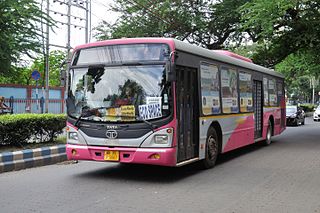
The transport system of Kolkata, a city in India, is a mix of modern mass rapid transport and old transport modalities like rickshaws. Kolkata is connected to the rest of India by the National Highways, the extensive network of the Indian Railways, National Waterways and by air. The most traffic to Northeast India route is via Kolkata.

Khidirpur or Kidderpore is a neighbourhood of South Kolkata in Kolkata district in the Indian state of West Bengal.

Jodhpur Park is a neighbourhood of South Kolkata, in Kolkata district, West Bengal, India.
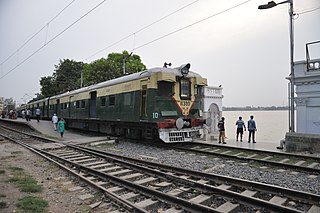
Kolkata Circular Railway, also known as the Kolkata Chakra Rail, is a 36.20 km (22.49 mi) long railway loop line operated by the Sealdah division of the Eastern Railway zone of Indian Railways, encircling the city of Kolkata.

Calcutta State Transport Corporation (CSTC) was a West Bengal state government undertaken transport corporation. Headquartered in Kolkata, it was set up on 31 July 1948. Currently it operates under the name WBTC. It plied buses in Kolkata and nearby districts of West Bengal, along with some long-distance services. CSTC owned 11 depots in Kolkata and the districts to station its fleet of busses.
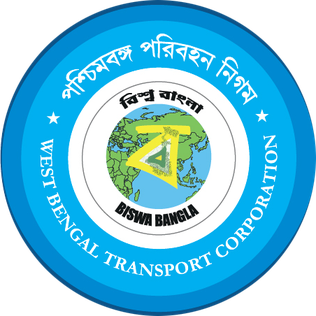
West Bengal Transport Corporation (WBTC) is a West Bengal state government undertaken corporation. It plies buses, trams and ferries in the state. It was formed by merging existing state transport agencies, namely the Calcutta State Transport Corporation, the Calcutta Tramways Company and the West Bengal Surface Transport Corporation.

Rajabazar is a locality in the city of Kolkata in West Bengal, India. It is located between CIT Road and APC Road. The locality has developed around Narkeldanaga Main Road, which acts as a connector between CIT Road and APC Road. Thus, Rajabazar can be said to be located between Maniktala, Narkeldanga and Sealdah.

Joka is a locality in South West Kolkata, India. It is a part of greater Behala region. This place is mostly known for Indian Institute of Management Calcutta and ESIC Medical College and Hospital.
Pilkhana is a neighbourhood in Howrah, West Bengal, India. It was the slum about which Dominique Lapierre's bestselling book City of Joy was written. Pilkhana has at least tens of thousands of residents. It is near to Howrah Station. A Haliman High School exists here. The area has significant Hindu and Muslim populations. Pilkhana is of industrial character. It is a part of Howrah Uttar. The Salesians of Don Bosco are present in Pilkhana.

Mahanayak Uttam Kumar is an at-grade level metro station on the North-South corridor of the Blue Line of Kolkata Metro which is located in Tollygunge area in Kolkata, West Bengal, India.
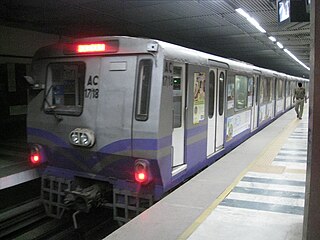
Rabindra Sarobar is an underground metro station on the North-South corridor of the Blue Line of Kolkata Metro in Kolkata, West Bengal, India. It is situated on Shyama Prasad Mukherjee Road at Charu Chandra Avenue in Charu Market, Tollygunge. The station is named after Rabindra Sarobar, an artificial lake and the surrounding area of South Kolkata. It is followed by the station Mahanayak Uttam Kumar towards Kavi Subhash and is preceded by Kalighat station towards Noapara and Dum Dum.

Jatin Das Park or JD Park is an underground metro station on the North-South corridor of the Blue Line of Kolkata Metro which is located on Shyama Prasad Mukherjee Road at Hazra, Kalighat in Kolkata, West Bengal, India.

Mahatma Gandhi Road is an underground metro station on the North-South corridor of the Blue Line of Kolkata Metro in Kolkata, West Bengal, India. The station is located on Chittaranjan Avenue, close to Burrabazar.

The tram system in Kolkata, the capital city of the Indian state of West Bengal, operated by West Bengal Transport Corporation (WBTC) after Calcutta Tramways Company (CTC) was dissolved, is the oldest tram network operating in India, and oldest operating tramway in Asia. Started in 1902, it is the oldest electric tramway in India. It is the only operating tram network of India at present.
Lake Gardens is a neighbourhood of South Kolkata, in Kolkata district, West Bengal, India. It has Kalighat to the north, Jodhpur Park to the east, Prince Anwar Shah Road or Tollygunge to the south and Charu Market to the west.


